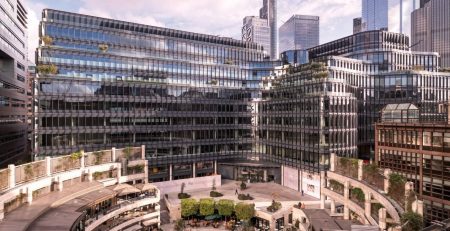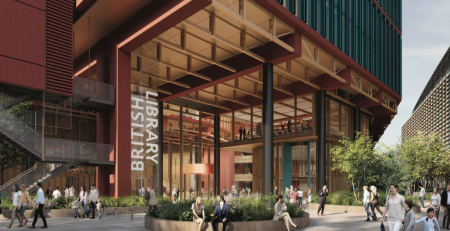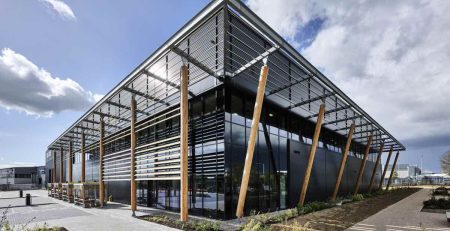What was The Buzz in November?
Our monthly roundup of real estate industry news.
Here are a few of the stories that caught our attention in October. From a surge in office leasing activity and new UK development plans, to the introduction of a new ‘Circularity Score’ to measure the reuse of materials in development and refurbishment projects, there’s plenty of progress happening in the UK commercial real estate sector.
Big Ten office take-up jumps in Q3 2024, reporting the highest quarterly levels since 2021
BNP Paribas Real Estate announced that the Big Ten UK regional office market recorded a surge in leasing activity in Q3 2024.
According to the latest data, regional office take-up increased 35.6% year-on-year to reach 1.47 million sq ft, reflecting the highest quarterly take-up since Q4 2021 at 1.66m sq ft. Leasing activity was boosted by a return of larger deals over 50,000 sq ft, particularly across Manchester and Birmingham.
The government/education sector accounted for the largest share of take-up in Q3 2024 at 27%, followed by professional services (25%) and banking/finance (17%).
Demand for best-in-class space continues to add pressure to prime rents, which increased 6.9% year-on-year on average across the Big Ten regional markets. Bristol leads the way at £48 per sq ft, followed by Edinburgh (£46), Manchester (£44), Birmingham (£42.50) and Glasgow (£39.50).
The increase in prime rents has been steered by pre-lets on upcoming office developments as companies continue acting quickly to secure space within the relatively limited development pipeline. Over a third of office space under construction has been pre-let, with further pre-let deals under offer and expected to complete in Q4.
The Crown Estate unveils £1.5bn redevelopment plans for Cambridge Business Park for science, innovation & technology
Cambridge Business Park is set to contribute to a new innovation ecosystem in Northeast Cambridge, providing a variety of office and lab spaces for start-ups and established businesses, alongside a residential, leisure and cultural offer for the wider community. It will greatly support the UK’s science, innovation, and technology ambitions.
Led by The Crown Estate, the mixed-use regeneration project worth £1.5bn will support the Government’s focus on keeping the UK at the forefront of global innovation. This builds further on The Crown Estate’s recent partnerships with Great British Energy to accelerate the deployment of renewable energy, and with Pioneer Group and Oxford Science Enterprise to deliver a new 100,000sq ft life sciences, technology and innovation space in the heart of Oxford.
As a major national landowner, The Crown Estate has a proven track record of enabling innovation and generating long-term social value, and is driven by its remit to create economic, social, and environmental value for the nation. Through redeveloping Cambridge Business Park, it intends to create an inclusive destination; connecting ideas, people, and industries that facilitate important science innovations with tangible social impact.
This is part of The Crown Estate’s wider long-term ambition to invest up to £1.5 billion in the science, technology, and innovation sectors nationally over the next 15 years. Supported by the creation of a globally significant Innovation District in Northeast Cambridge, the proposals will nurture homegrown skills and enable businesses to scale up in the UK and attract investment.
Dan Labbad, CEO at The Crown Estate, comments: “The Crown Estate is investing where it can have the most meaningful impact in addressing areas of national need, meeting local challenges and realising opportunities. Our vision for Cambridge Business Park is to create an inclusive and connected place that is industry leading in terms of sustainable and innovative workspace.
GPE introduces new ‘circularity score’ to measure the quantity of reused materials
Great Portland Estates has set a new circular economy target by introducing a ‘Circularity Score’ to measure the reuse of materials in its development and refurbishment projects. This initiative is part of GPE’s strategy to achieve net-zero carbon by 2040 and cut embodied carbon by 52% by 2030.
The company has already demonstrated its commitment by repurposing steel from a deconstructed building for a new scheme at 30 Duke Street, St James’s, UK.
Projects starting after 1 April 2025 will aim for a minimum reuse score of 40%, increasing to 50% for those commencing after 1 April 2030. GPE’s long-term goal is to surpass 60% circularity in all new projects by 2040.
Notably, 1,700 tonnes (t) of steel from Aldermanbury Square are being repurposed for the aforementioned St James’s development. This initiative is part of GPE’s refined approach to constructing ‘circular buildings’, significantly reducing the need for virgin materials and delivering high-quality, low-carbon, climate-resilient spaces.
Office new builds overtake refurbs for first time in four years
The level of office refurbishment starts has dropped below new build work for the first time since early 2020 in London.
The winter 2024 edition of the Deloitte London Office Crane Survey also revealed a decline in new construction starts and a decrease in delivered projects.
The survey – which collected data between April and September 2024 – recorded 3.7 million sq ft of new office construction starts across 29 schemes, representing a 12% decrease in volume compared to the previous survey. The figure remained above the 10-year average of 3.4 million sq ft.
Researchers recorded the start of 1.2 million sq ft across 18 refurbishment schemes – which represented a 57% decrease compared to the volume recorded in the previous survey. For the first time in 4.5 years, volumes of new build traditional offices marginally exceeded those of refurbishment.
Philip Parnell, partner and head of valuation and real estate climate & sustainability lead at Deloitte, said: “Refurbishment levels have pared back markedly in this survey from previous high levels, and likely a reaction to the economic, geopolitical and wider global concerns prevailing during the survey period.”
Chetwoods’ £1bn Smithfield Market relocation project halted
Chetwoods confirmed to the AJ that work on the megaproject planned for the former Barking Reach Power Station had stopped.
The City of London Corporation bought the Dagenham site for around £125 million in 2018, but voted last week to absolve itself of continuing to operate both Smithfield and Billingsgate markets and to ditch the Dagenham relocation plan, saying the move had become ‘unaffordable’.
The corporation confirmed that a private meeting of its Court of Common Council on 26 November ‘ratified a decision to end its interest in co-locating the wholesale food markets of Smithfield and Billingsgate to a new site at Dagenham Dock’.
As well as modern, sustainable facilities for market tenants, the Dagenham site would have provided a training school for market traders and food workers in Barking and Dagenham.
This week a Chetwoods spokesperson told the AJ: ‘In line with the City of London Corporation’s public statement, consultants have been asked to pause work on the project.’
In a statement, the City of London Corporation said the decision to scrap the plan ‘reflects a careful balance between respecting the history of Smithfield and Billingsgate markets and managing resources for this project responsibly’.












